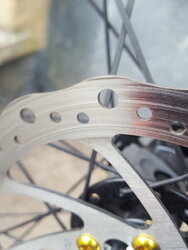I have just checked my CX bike and reminded myself how the brakes are adjusted ...
The pads are very close to the rotors, but not touching. There is not room to get a business card between pad and rotor, so say about half the thickness of the card away.
You want the rotor midway between the pads. Achieve that by slackening the bolts holding the brake on, and then apply the brake. Retighten the bolts while the brake pads are squeezing the rotor. That should have centred everything nicely. (Check by looking down at the brake and observing the gaps either side of the rotor without the brake applied.)
Now you need to take up the slack in the cable. Slacken the cable off so the brake lever can be pulled slightly without operating the brake. Gradually tighten the cable until there is no slack left. At that point, the slightest movement in the lever starts to apply the brake. You should not tighten beyond that point or you will be compromising the ability of the brake to compensate for pad wear. Check that you have not overtightened by pushing in the black spring-loaded knurled pin on the brake assembly and ensuring that it will still screw in. If you can't get it to screw in then you overtightened the cable. Release the pin again.
If you have done all of that and the brake power is still inadequate then you might have contaminated pads or rotor.
The only other thing that occurs to me is that you might have cheapo brake cable outers which are compressing when you apply the brake. If so, replace them with better quality ones.
If the brakes still don't work then I am baffled!

I replaced my bad front brake with a Hy/Rd and it stops me fine on our steep local descents.
Good luck!


 I replaced my bad front brake with a Hy/Rd and it stops me fine on our steep local descents.
I replaced my bad front brake with a Hy/Rd and it stops me fine on our steep local descents.